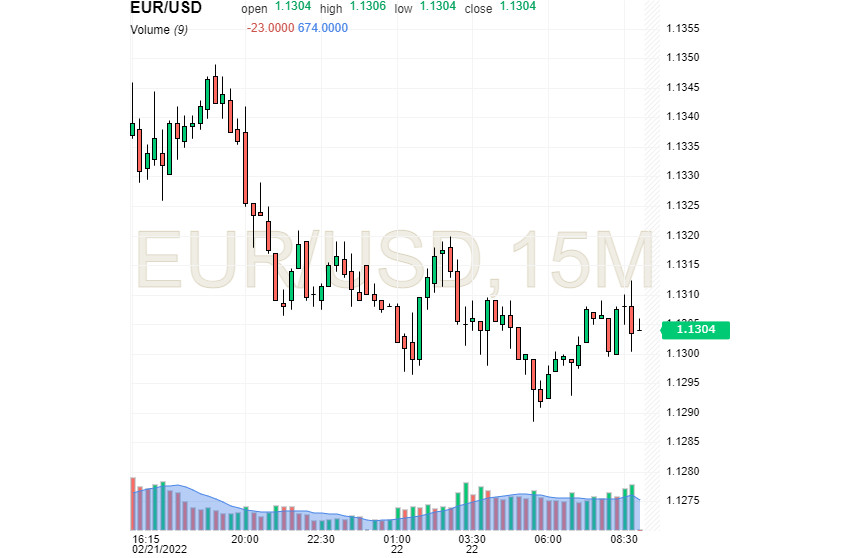
At the beginning of this week, risk aversion prevailed on the global market amid the heat of geopolitical passions between Russia and Ukraine. This puts pressure on the euro and supports the greenback. However, at any moment the situation can change dramatically.
In the short and medium term, the risks of collapse of risky assets remain. The reason is the difficult situation around Ukraine, in particular in the Donbas. Against this background, the markets hurried to put a successful solution to geopolitical problems in the prices, experts believe.
The current instability has negatively affected the key currencies, "taking" most of the minor ones. Analysts, given the persistence of geopolitical tensions and the absence of other key market drivers, are confident in the growth of safe haven currencies. The dollar plays the first fiddle here, then the yen and the Swiss franc are added to the general chorus. This week, the shield currencies will receive some support, experts believe.
The US currency expects that the Federal Reserve will extend a "helping hand" to it. Recall that the markets are waiting for confirmation of a possible Fed rate hike in March (by 50 bps). The relative confidence of the markets is supported by the upcoming speech of the hawks from the FOMC, which is scheduled for this week.
The dissonance in the expectations of the greenback was introduced by the uncertainty of the central bank's representatives regarding the timing of the rate hike. It seems that the Fed has temporarily stepped back, taking a step back in tightening monetary policy. As a result, the cautious comments of the central bank's representatives slightly weakened the demand for USD.
Last Friday, February 18, John Williams, president of the Federal Reserve Bank of New York, stressed the expediency of raising the rate in March. The official adheres to the idea of "slow progress" in relation to raising rates. It should be noted that many FOMC representatives are afraid of "excessive gestures" in the issue of tightening the policy and the negative impact of the measures taken on economic growth. Such measures include a rapid rise in the interest rate in March (by 50 percentage points).
Ambiguous data on the producer price index in the United States add fuel to the fire. According to reports, in January 2022, this indicator increased by 9.7%, while economists' forecasts fell within the value of 9.1%. This is not just a wake-up call, but a real alarm bell for the economy, experts are sure. In the current situation, delay on the part of the Fed is unacceptable.
However, none of the central banks demonstrate haste in raising rates. The delay is noted not only by the Fed. The European Central Bank also took up the baton of slowness. It resembles the tactics of tigers stalking in the financial jungle. Cautious sentiment in the eurozone has intensified amid mixed macroeconomic indicators.
According to current estimates, the total eurozone PMI rose to 55.8 points against the projected 52.7 points, reaching a record level over the past five months. At the same time, in February, the purchasing managers' index in the manufacturing sector (PMI) amounted to 58.4 points, being at a low for two months. As for the index of business activity in the eurozone services sector, it soared by 55.8 points against the expected 52 points. The indicator showed a three-month high, alarming experts.
Analyzing the overall macroeconomic situation, experts note that the eurozone economy has regained its dynamics. This was facilitated by the renewed demand for a number of consumer services, such as travel, recreation and entertainment. Additional assistance was provided by a partial solution to the supply problem.
However, the positive effect of the optimistic business indicators of the eurozone has significantly decreased due to the complication of the geopolitical situation. This provoked the "escape" of investors from risks and reduced the demand for risky currencies, in particular for the European one. The current state of affairs has provoked an imbalance in the EUR/USD pair. On Monday, February 21, the classic pair reached a high level of 1.1390, but these achievements came to naught. On the morning of Tuesday, February 22, the EUR/USD pair was trading at 1.1304.

The European currency has to expend a lot of energy to stay afloat. However, the EUR is powerless against geopolitics, experts emphasize. On Tuesday, the euro sank noticeably, reflecting the strengthening of the geopolitical conflict between Russia and Ukraine. The macro data of the eurozone have little impact on the euro against the background of the ongoing confrontation, analysts believe.
The EUR/USD pair showed a bullish momentum at the beginning of this week, rising above 1.1350 amid risk appetite. Optimistic economists expect the pair to conquer a new peak – 1,1400, but in light of current events, this is unlikely. The tense background contributes to the global subsidence of leading financial assets, the withdrawal of investors into protective currencies and the ignoring of risky ones.





















